spare tire TOYOTA AURIS TOURING SPORTS 2016 Owners Manual
[x] Cancel search | Manufacturer: TOYOTA, Model Year: 2016, Model line: AURIS TOURING SPORTS, Model: TOYOTA AURIS TOURING SPORTS 2016Pages: 660, PDF Size: 17.28 MB
Page 6 of 660
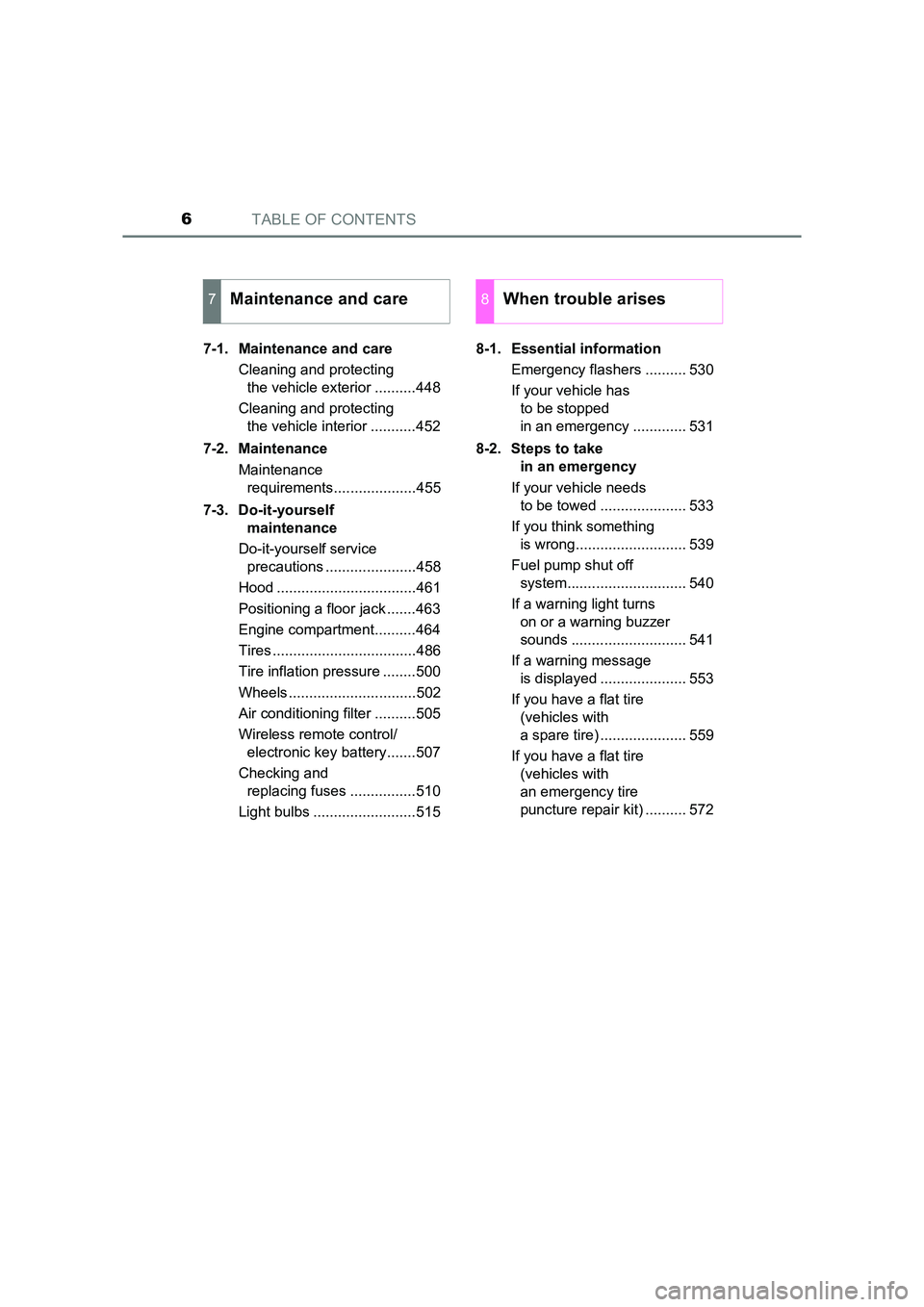
TABLE OF CONTENTS6
AURIS Touring Sports_EE (12K53E)7-1. Maintenance and care
Cleaning and protecting the vehicle exterior ..........448
Cleaning and protecting the vehicle interior ...........452
7-2. Maintenance Maintenance requirements....................455
7-3. Do-it-yourself maintenance
Do-it-yourself service precautions ......................458
Hood ..................................461
Positioning a floor jack .......463
Engine compartment..........464
Tires ...................................486
Tire inflation pressure ........500
Wheels ...............................502
Air conditioning filter ..........505
Wireless remote control/ electronic key battery.......507
Checking and replacing fuses ................510
Light bulbs .........................515 8-1. Essential information
Emergency flashers .......... 530
If your vehicle has to be stopped
in an emergency ............. 531
8-2. Steps to take in an emergency
If your vehicle needs to be towed ..................... 533
If you think something is wrong........................... 539
Fuel pump shut off system............................. 540
If a warning light turns on or a warning buzzer
sounds ............................ 541
If a warning message is displayed ..................... 553
If you have a flat tire (vehicles with
a spare tire) ..................... 559
If you have a flat tire (vehicles with
an emergency tire
puncture repair kit) .......... 572
7Maintenance and care8When trouble arises
Page 208 of 660
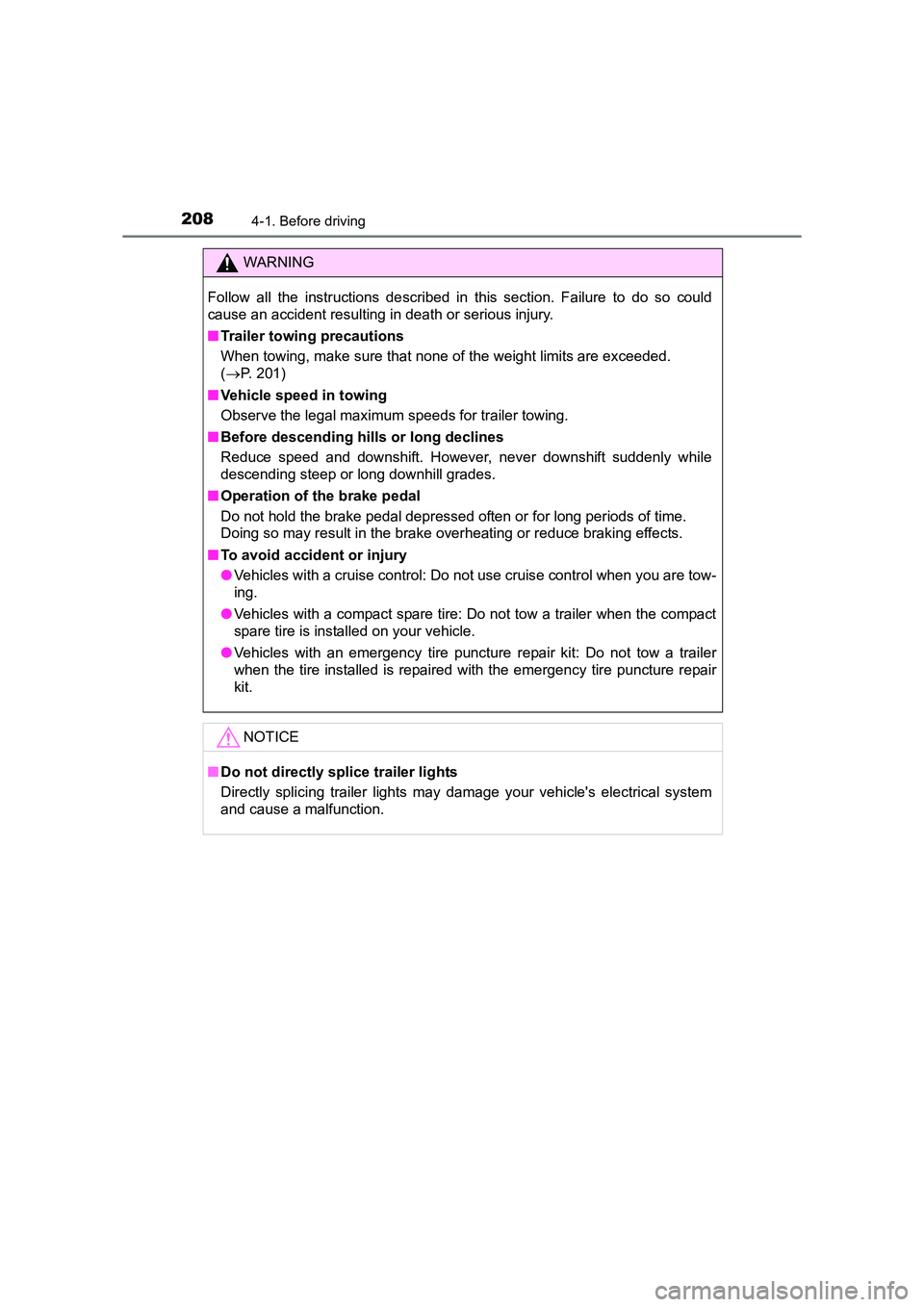
2084-1. Before driving
AURIS Touring Sports_EE (12K53E)
WARNING
Follow all the instructions described in this section. Failure to do so could
cause an accident resulting in death or serious injury.
‚Ė† Trailer towing precautions
When towing, make sure that none of the weight limits are exceeded.
(‚Üí P. 201)
‚Ė† Vehicle speed in towing
Observe the legal maximum speeds for trailer towing.
‚Ė† Before descending hills or long declines
Reduce speed and downshift. However, never downshift suddenly while
descending steep or long downhill grades.
‚Ė† Operation of the brake pedal
Do not hold the brake pedal depressed often or for long periods of time.
Doing so may result in the brake overheating or reduce braking effects.
‚Ė† To avoid accident or injury
‚óŹVehicles with a cruise control: Do not use cruise control when you are tow-
ing.
‚óŹ Vehicles with a compact spare tire: Do not tow a trailer when the compact
spare tire is installed on your vehicle.
‚óŹ Vehicles with an emergency tire puncture repair kit: Do not tow a trailer
when the tire installed is repaired with the emergency tire puncture repair
kit.
NOTICE
‚Ė† Do not directly splice trailer lights
Directly splicing trailer lights may damage your vehicle's electrical system
and cause a malfunction.
Page 257 of 660
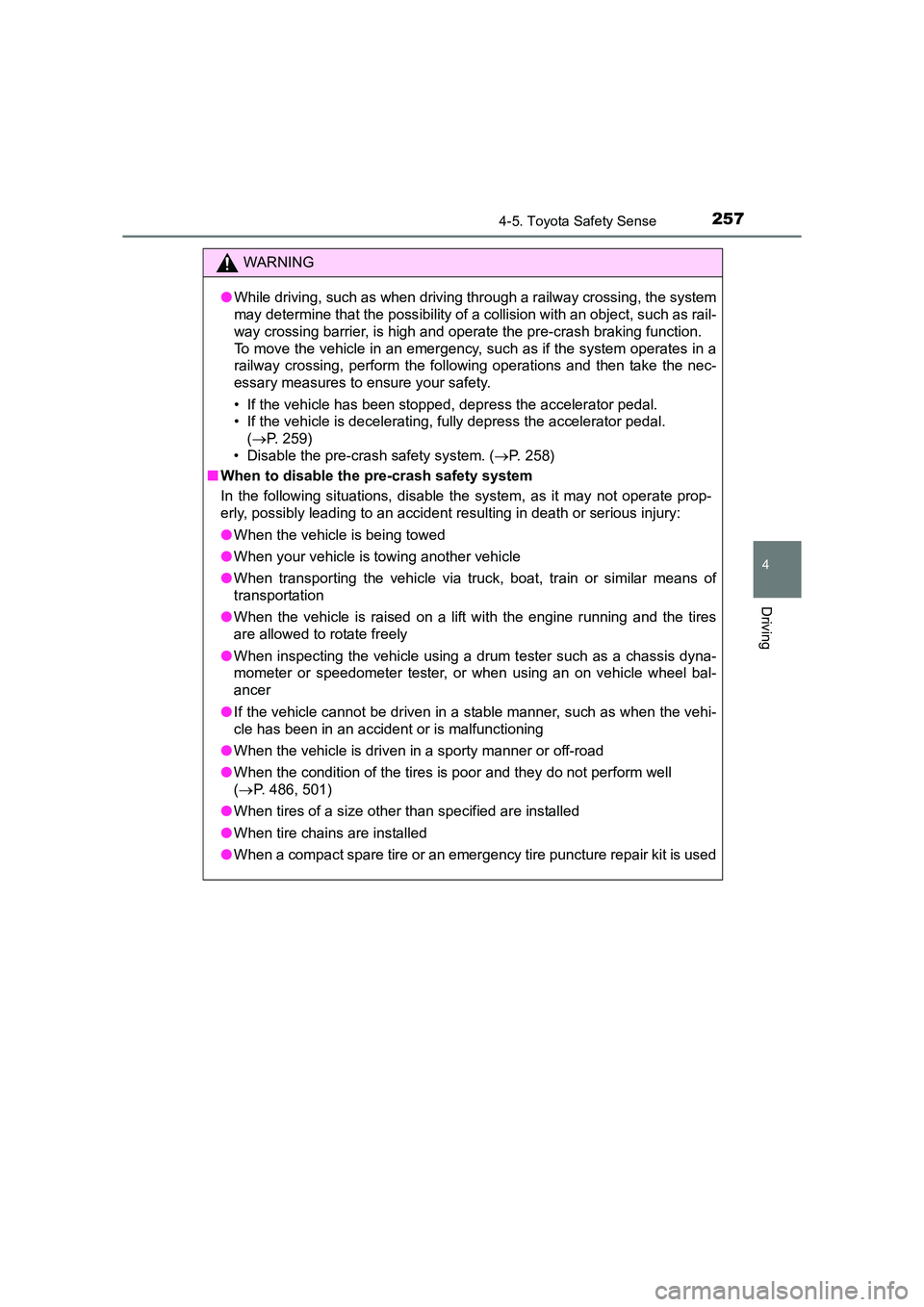
2574-5. Toyota Safety Sense
AURIS Touring Sports_EE (12K53E)
4
Driving
WARNING
‚óŹ While driving, such as when driving through a railway crossing, the system
may determine that the possibility of a collision with an object, such as rail-
way crossing barrier, is high and operate the pre-crash braking function.
To move the vehicle in an emergency, such as if the system operates in a
railway crossing, perform the following operations and then take the nec-
essary measures to ensure your safety.
‚ÄĘ If the vehicle has been stopped, depress the accelerator pedal.
‚ÄĘ If the vehicle is decelerating, fully depress the accelerator pedal.
(‚Üí P. 259)
‚ÄĘ Disable the pre-crash safety system. ( ‚ÜíP. 258)
‚Ė† When to disable the pre-crash safety system
In the following situations, disable the system, as it may not operate prop-
erly, possibly leading to an accident resulting in death or serious injury:
‚óŹWhen the vehicle is being towed
‚óŹ When your vehicle is towing another vehicle
‚óŹ When transporting the vehicle via truck, boat, train or similar means of
transportation
‚óŹ When the vehicle is raised on a lift with the engine running and the tires
are allowed to rotate freely
‚óŹ When inspecting the vehicle using a drum tester such as a chassis dyna-
mometer or speedometer tester, or when using an on vehicle wheel bal-
ancer
‚óŹ If the vehicle cannot be driven in a stable manner, such as when the vehi-
cle has been in an accident or is malfunctioning
‚óŹ When the vehicle is driven in a sporty manner or off-road
‚óŹ When the condition of the tires is poor and they do not perform well
( ‚Üí P. 486, 501)
‚óŹ When tires of a size other than specified are installed
‚óŹ When tire chains are installed
‚óŹ When a compact spare tire or an emergency tire puncture repair kit is used
Page 324 of 660
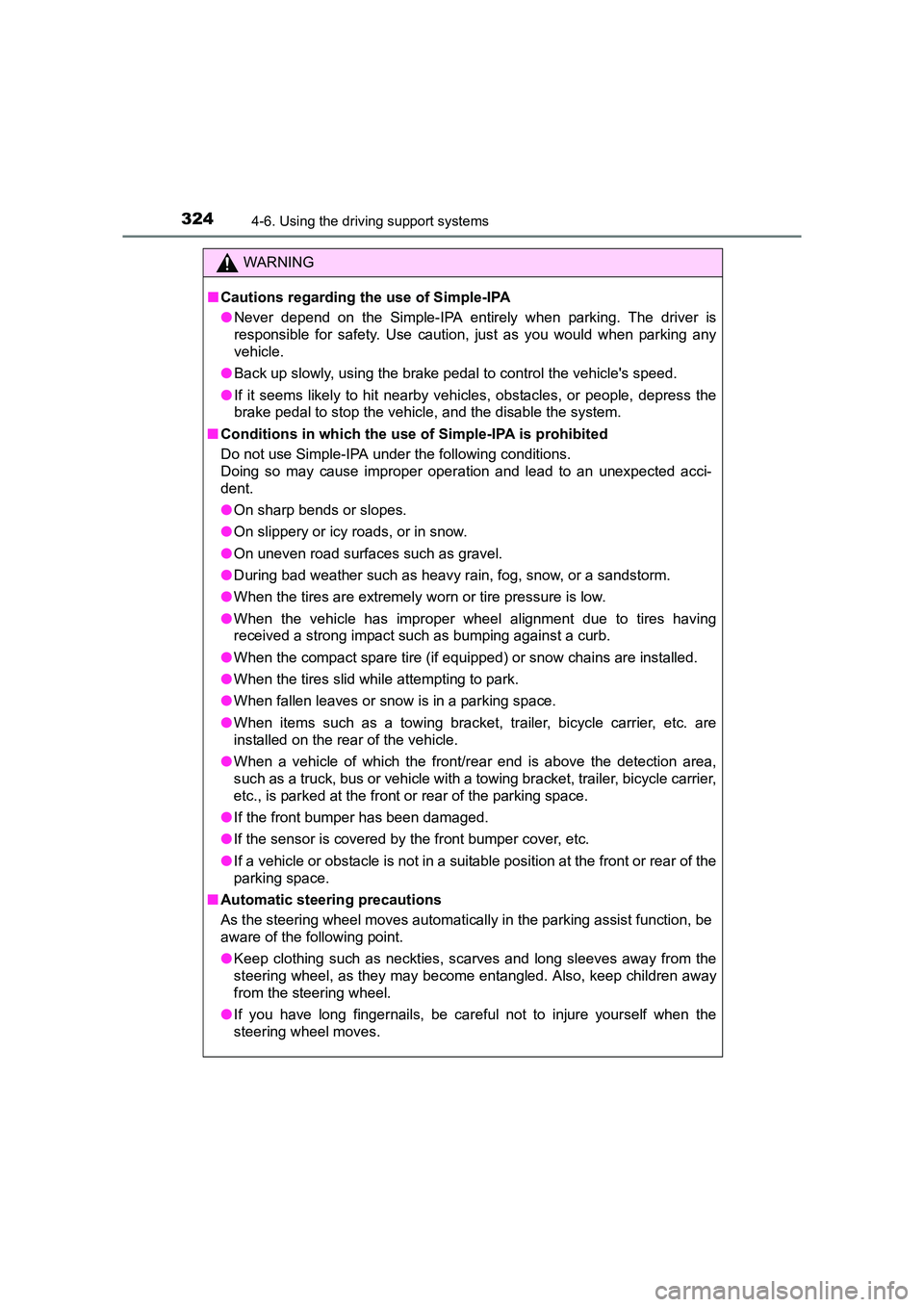
3244-6. Using the driving support systems
AURIS Touring Sports_EE (12K53E)
WARNING
‚Ė† Cautions regarding the use of Simple-IPA
‚óŹNever depend on the Simple-IPA entirely when parking. The driver is
responsible for safety. Use caution, just as you would when parking any
vehicle.
‚óŹ Back up slowly, using the brake pedal to control the vehicle's speed.
‚óŹ If it seems likely to hit nearby vehicles, obstacles, or people, depress the
brake pedal to stop the vehicle, and the disable the system.
‚Ė† Conditions in which the use of Simple-IPA is prohibited
Do not use Simple-IPA under the following conditions.
Doing so may cause improper operation and lead to an unexpected acci-
dent.
‚óŹOn sharp bends or slopes.
‚óŹ On slippery or icy roads, or in snow.
‚óŹ On uneven road surfaces such as gravel.
‚óŹ During bad weather such as heavy rain, fog, snow, or a sandstorm.
‚óŹ When the tires are extremely worn or tire pressure is low.
‚óŹ When the vehicle has improper wheel alignment due to tires having
received a strong impact such as bumping against a curb.
‚óŹ When the compact spare tire (if equipped) or snow chains are installed.
‚óŹ When the tires slid while attempting to park.
‚óŹ When fallen leaves or snow is in a parking space.
‚óŹ When items such as a towing bracket, trailer, bicycle carrier, etc. are
installed on the rear of the vehicle.
‚óŹ When a vehicle of which the front/rear end is above the detection area,
such as a truck, bus or vehicle with a towing bracket, trailer, bicycle carrier,
etc., is parked at the front or rear of the parking space.
‚óŹ If the front bumper has been damaged.
‚óŹ If the sensor is covered by the front bumper cover, etc.
‚óŹ If a vehicle or obstacle is not in a suit able position at the front or rear of the
parking space.
‚Ė† Automatic steering precautions
As the steering wheel moves automatically in the parking assist function, be
aware of the following point.
‚óŹKeep clothing such as neckties, scarves and long sleeves away from the
steering wheel, as they may become entangled. Also, keep children away
from the steering wheel.
‚óŹ If you have long fingernails, be careful not to injure yourself when the
steering wheel moves.
Page 486 of 660
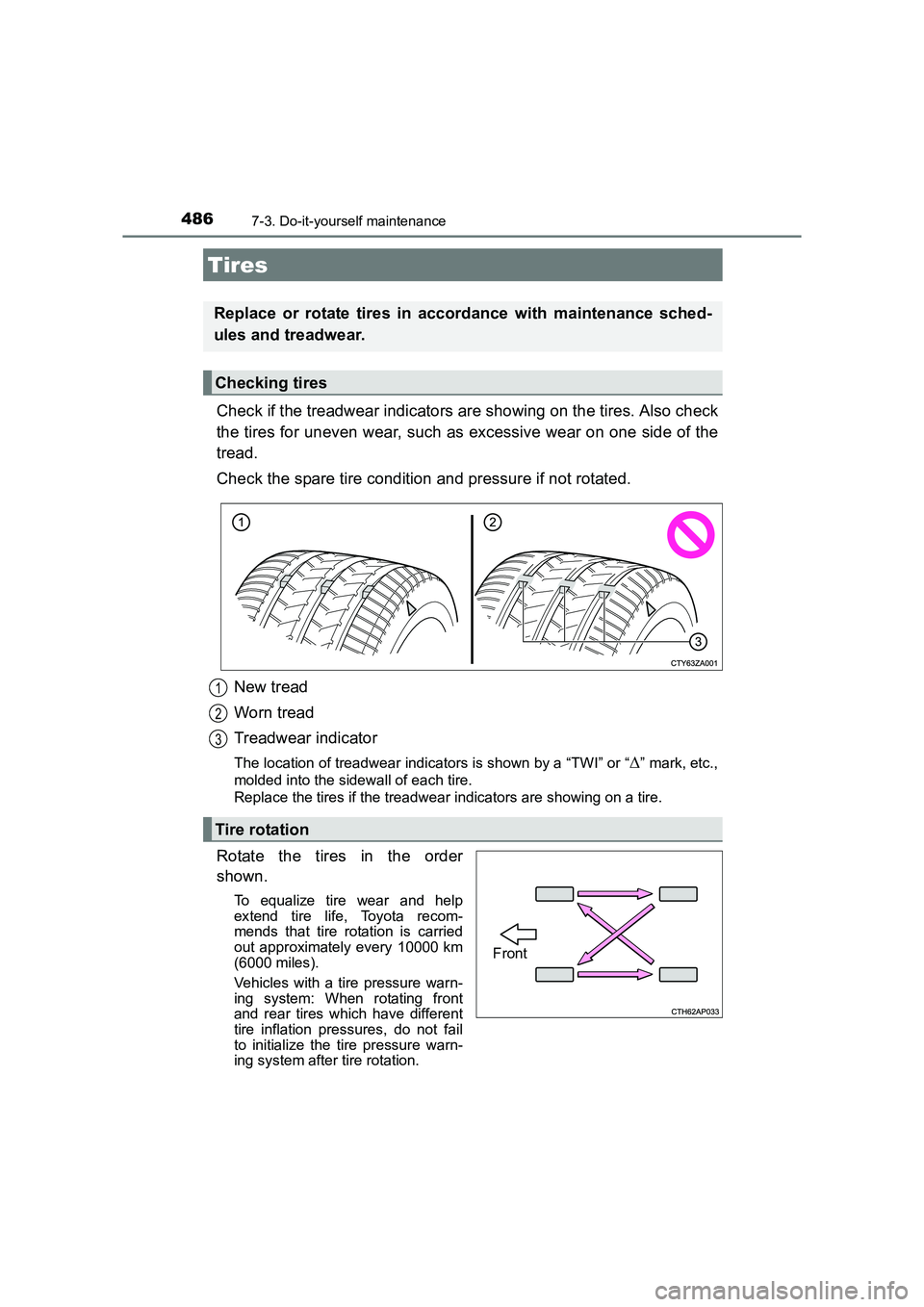
4867-3. Do-it-yourself maintenance
AURIS Touring Sports_EE (12K53E)
Check if the treadwear indicators are showing on the tires. Also check
the tires for uneven wear, such as excessive wear on one side of the
tread.
Check the spare tire condition and pressure if not rotated.New tread
Worn tread
Treadwear indicator
The location of treadwear indicators is shown by a ‚ÄúTWI‚ÄĚ or ‚Äú‚ąÜ‚ÄĚ mark, etc.,
molded into the sidewall of each tire.
Replace the tires if the treadwear indicators are showing on a tire.
Rotate the tires in the order
shown.
To equalize tire wear and help
extend tire life, Toyota recom-
mends that tire rotation is carried
out approximately every 10000 km
(6000 miles).
Vehicles with a tire pressure warn-
ing system: When rotating front
and rear tires which have different
tire inflation pressures, do not fail
to initialize the tire pressure warn-
ing system after tire rotation.
Tires
Replace or rotate tires in accordance with maintenance sched-
ules and treadwear.
Checking tires
Tire rotation
1
2
3
Front
Page 498 of 660
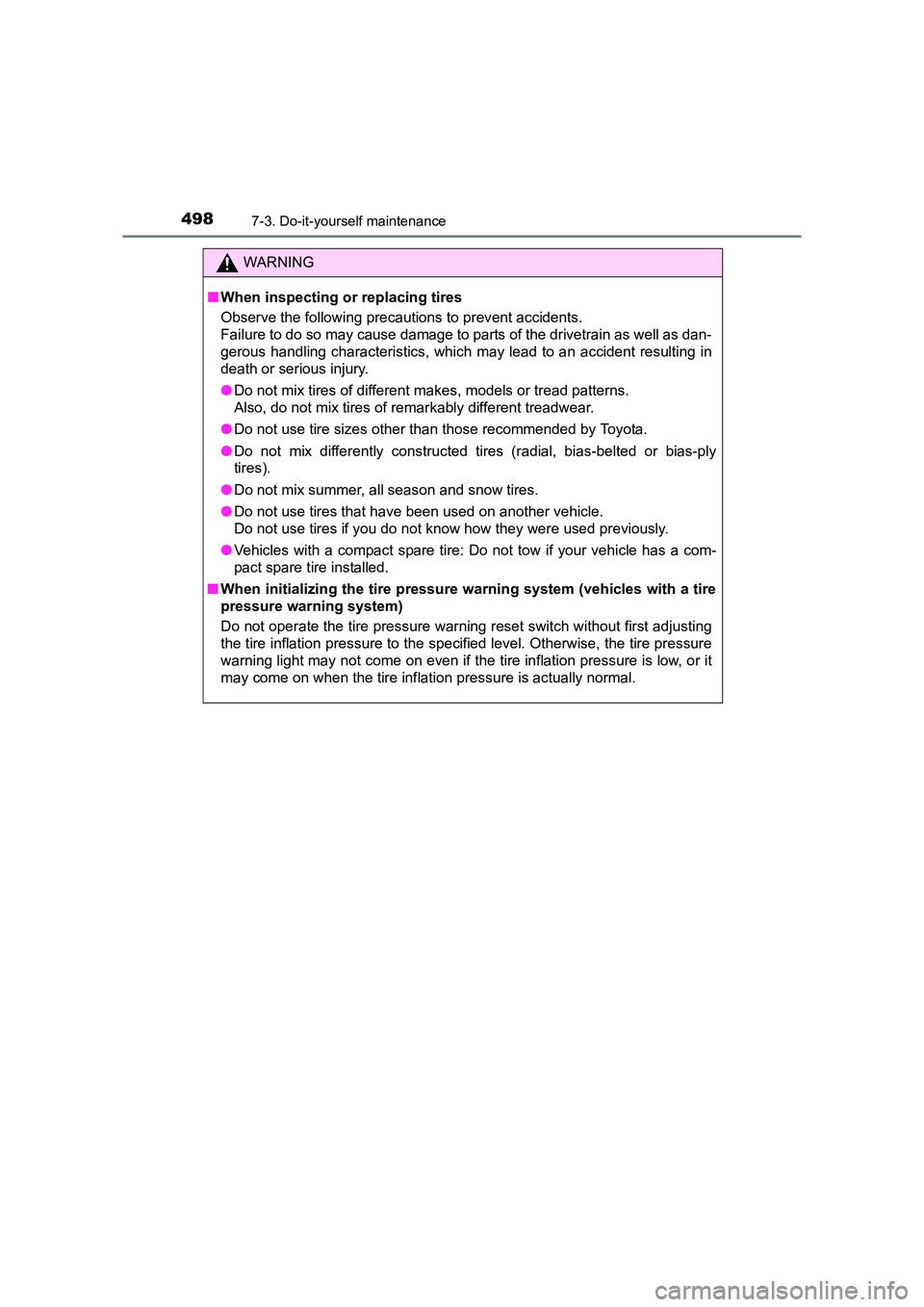
4987-3. Do-it-yourself maintenance
AURIS Touring Sports_EE (12K53E)
WARNING
‚Ė† When inspecting or replacing tires
Observe the following precautions to prevent accidents.
Failure to do so may cause damage to parts of the drivetrain as well as dan-
gerous handling characteristics, which may lead to an accident resulting in
death or serious injury.
‚óŹDo not mix tires of different makes, models or tread patterns.
Also, do not mix tires of remarkably different treadwear.
‚óŹ Do not use tire sizes other than those recommended by Toyota.
‚óŹ Do not mix differently constructed tires (radial, bias-belted or bias-ply
tires).
‚óŹ Do not mix summer, all season and snow tires.
‚óŹ Do not use tires that have been used on another vehicle.
Do not use tires if you do not know how they were used previously.
‚óŹ Vehicles with a compact spare tire: Do not tow if your vehicle has a com-
pact spare tire installed.
‚Ė† When initializing the tire pressure warning system (vehicles with a tire
pressure warning system)
Do not operate the tire pressure warning reset switch without first adjusting
the tire inflation pressure to the specified level. Otherwise, the tire pressure
warning light may not come on even if the tire inflation pressure is low, or it
may come on when the tire inflation pressure is actually normal.
Page 529 of 660
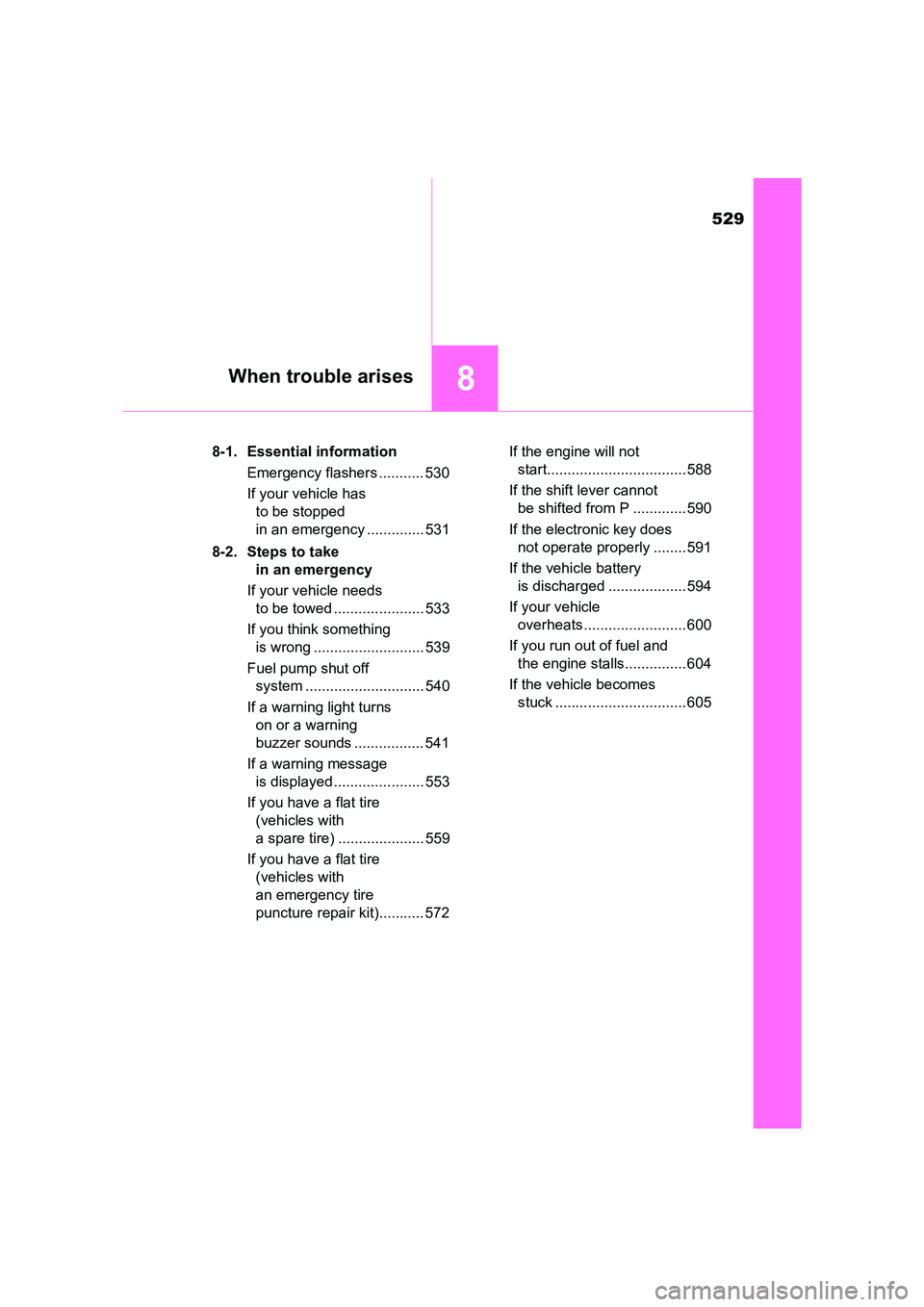
529
8When trouble arises
AURIS Touring Sports_EE (12K53E)8-1. Essential information
Emergency flashers ........... 530
If your vehicle has to be stopped
in an emergency .............. 531
8-2. Steps to take in an emergency
If your vehicle needs to be towed ...................... 533
If you think something is wrong ........................... 539
Fuel pump shut off system ............................. 540
If a warning light turns on or a warning
buzzer sounds ................. 541
If a warning message is displayed ...................... 553
If you have a flat tire (vehicles with
a spare tire) ..................... 559
If you have a flat tire (vehicles with
an emergency tire
puncture repair kit)........... 572 If the engine will not
start.................................. 588
If the shift lever cannot be shifted from P ............. 590
If the electronic key does not operate properly ........ 591
If the vehicle battery is discharged ................... 594
If your vehicle overheats ......................... 600
If you run out of fuel and the engine stalls...............604
If the vehicle becomes stuck ................................ 605
Page 549 of 660
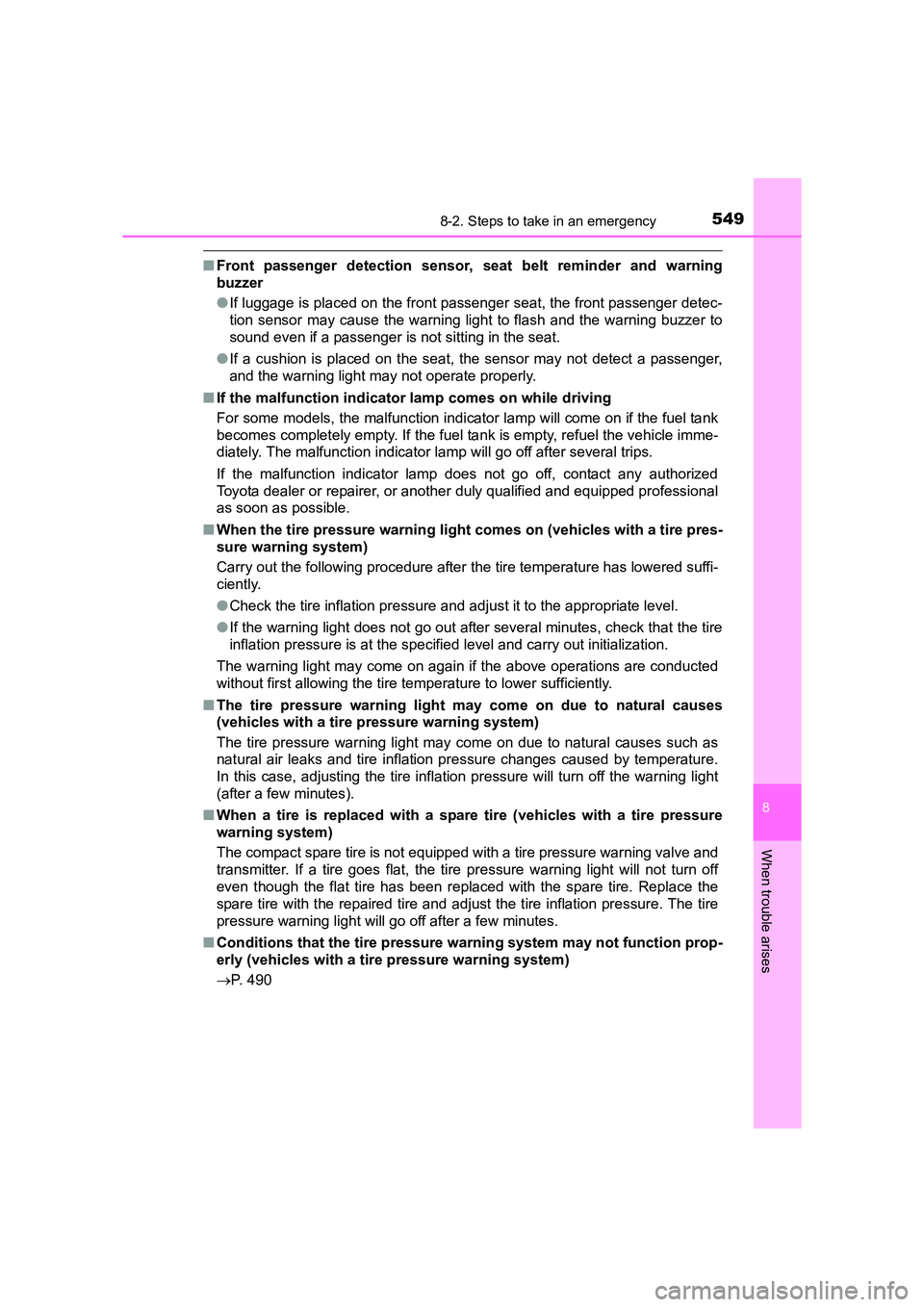
5498-2. Steps to take in an emergency
AURIS Touring Sports_EE (12K53E)
8
When trouble arises
‚Ė†Front passenger detection sensor, seat belt reminder and warning
buzzer
‚óŹ If luggage is placed on the front passenger seat, the front passenger detec-
tion sensor may cause the warning light to flash and the warning buzzer to
sound even if a passenger is not sitting in the seat.
‚óŹ If a cushion is placed on the seat, the sensor may not detect a passenger,
and the warning light may not operate properly.
‚Ė† If the malfunction indicator lamp comes on while driving
For some models, the malfunction indicator lamp will come on if the fuel tank
becomes completely empty. If the fuel tank is empty, refuel the vehicle imme-
diately. The malfunction indicator lamp will go off after several trips.
If the malfunction indicator lamp does not go off, contact any authorized
Toyota dealer or repairer, or another duly qualified and equipped professional
as soon as possible.
‚Ė† When the tire pressure warning light comes on (vehicles with a tire pres-
sure warning system)
Carry out the following procedure after the tire temperature has lowered suffi-
ciently.
‚óŹ Check the tire inflation pressure and adjust it to the appropriate level.
‚óŹ If the warning light does not go out after several minutes, check that the tire
inflation pressure is at the specified level and carry out initialization.
The warning light may come on again if the above operations are conducted
without first allowing the tire temperature to lower sufficiently.
‚Ė† The tire pressure warning light may come on due to natural causes
(vehicles with a tire pressure warning system)
The tire pressure warning light may come on due to natural causes such as
natural air leaks and tire inflation pressure changes caused by temperature.
In this case, adjusting the tire inflation pressure will turn off the warning light
(after a few minutes).
‚Ė† When a tire is replaced with a spare tire (vehicles with a tire pressure
warning system)
The compact spare tire is not equipped with a tire pressure warning valve and
transmitter. If a tire goes flat, the tire pressure warning light will not turn off
even though the flat tire has been replaced with the spare tire. Replace the
spare tire with the repaired tire and adjus t the tire inflation pressure. The tire
pressure warning light will go off after a few minutes.
‚Ė† Conditions that the tire pressure warning system may not function prop-
erly (vehicles with a ti re pressure warning system)
‚Üí P. 490
Page 551 of 660
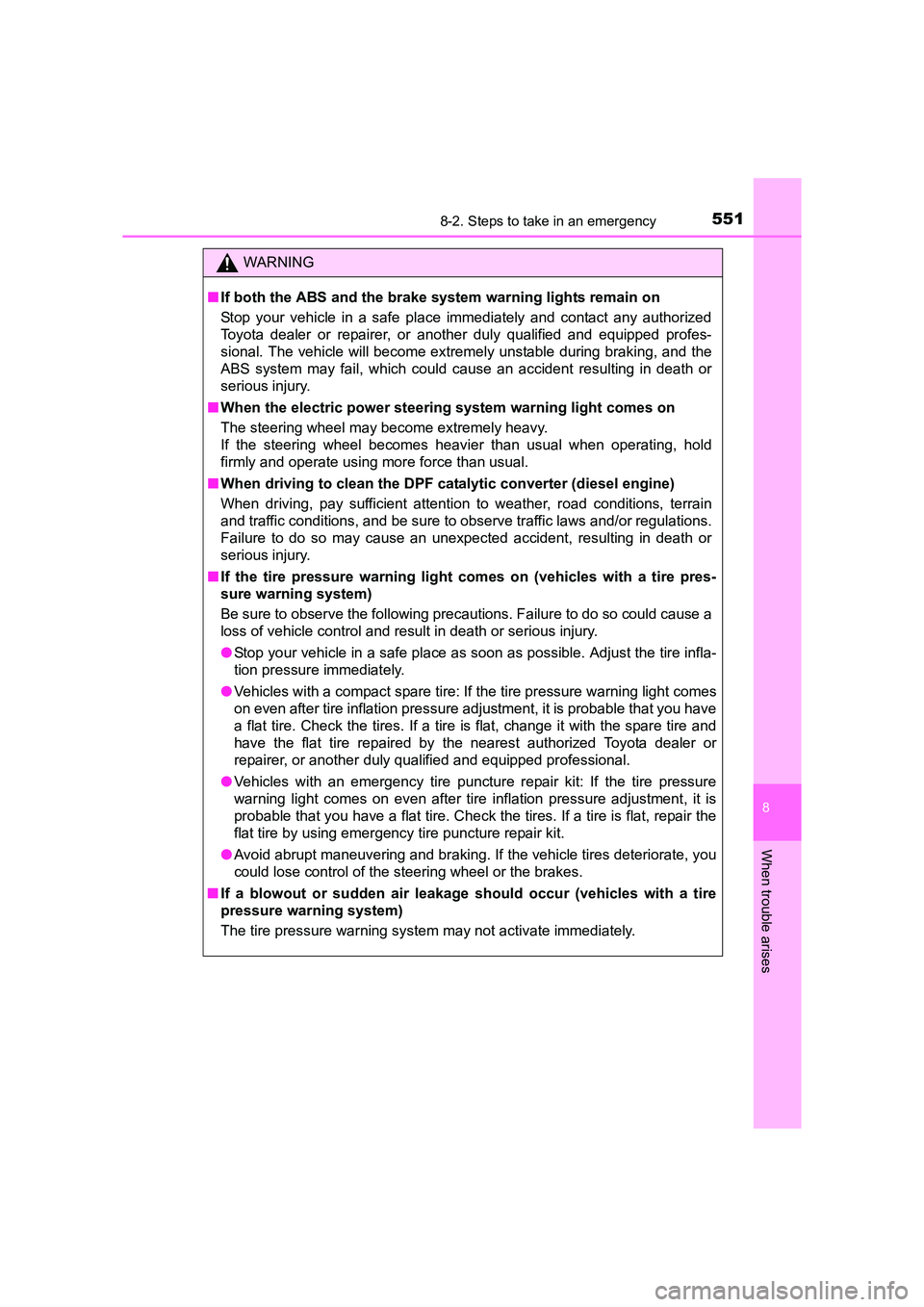
5518-2. Steps to take in an emergency
AURIS Touring Sports_EE (12K53E)
8
When trouble arises
WARNING
‚Ė† If both the ABS and the brake system warning lights remain on
Stop your vehicle in a safe place immediately and contact any authorized
Toyota dealer or repairer, or another duly qualified and equipped profes-
sional. The vehicle will become extremely unstable during braking, and the
ABS system may fail, which could cause an accident resulting in death or
serious injury.
‚Ė† When the electric power steering system warning light comes on
The steering wheel may become extremely heavy.
If the steering wheel becomes heavier than usual when operating, hold
firmly and operate using more force than usual.
‚Ė† When driving to clean the DPF cat alytic converter (diesel engine)
When driving, pay sufficient attention to weather, road conditions, terrain
and traffic conditions, and be sure to observe traffic laws and/or regulations.
Failure to do so may cause an unexpected accident, resulting in death or
serious injury.
‚Ė† If the tire pressure warning light comes on (vehicles with a tire pres-
sure warning system)
Be sure to observe the following precautions. Failure to do so could cause a
loss of vehicle control and result in death or serious injury.
‚óŹStop your vehicle in a safe place as soon as possible. Adjust the tire infla-
tion pressure immediately.
‚óŹ Vehicles with a compact spare tire: If the tire pressure warning light comes
on even after tire inflation pressure adjustment, it is probable that you have
a flat tire. Check the tires. If a tire is flat, change it with the spare tire and
have the flat tire repaired by the nearest authorized Toyota dealer or
repairer, or another duly qualified and equipped professional.
‚óŹ Vehicles with an emergency tire puncture repair kit: If the tire pressure
warning light comes on even after tire inflation pressure adjustment, it is
probable that you have a flat tire. Check the tires. If a tire is flat, repair the
flat tire by using emergency tire puncture repair kit.
‚óŹ Avoid abrupt maneuvering and braking. If the vehicle tires deteriorate, you
could lose control of the steering wheel or the brakes.
‚Ė† If a blowout or sudden air leakage should occur (vehicles with a tire
pressure warning system)
The tire pressure warning system may not activate immediately.
Page 559 of 660
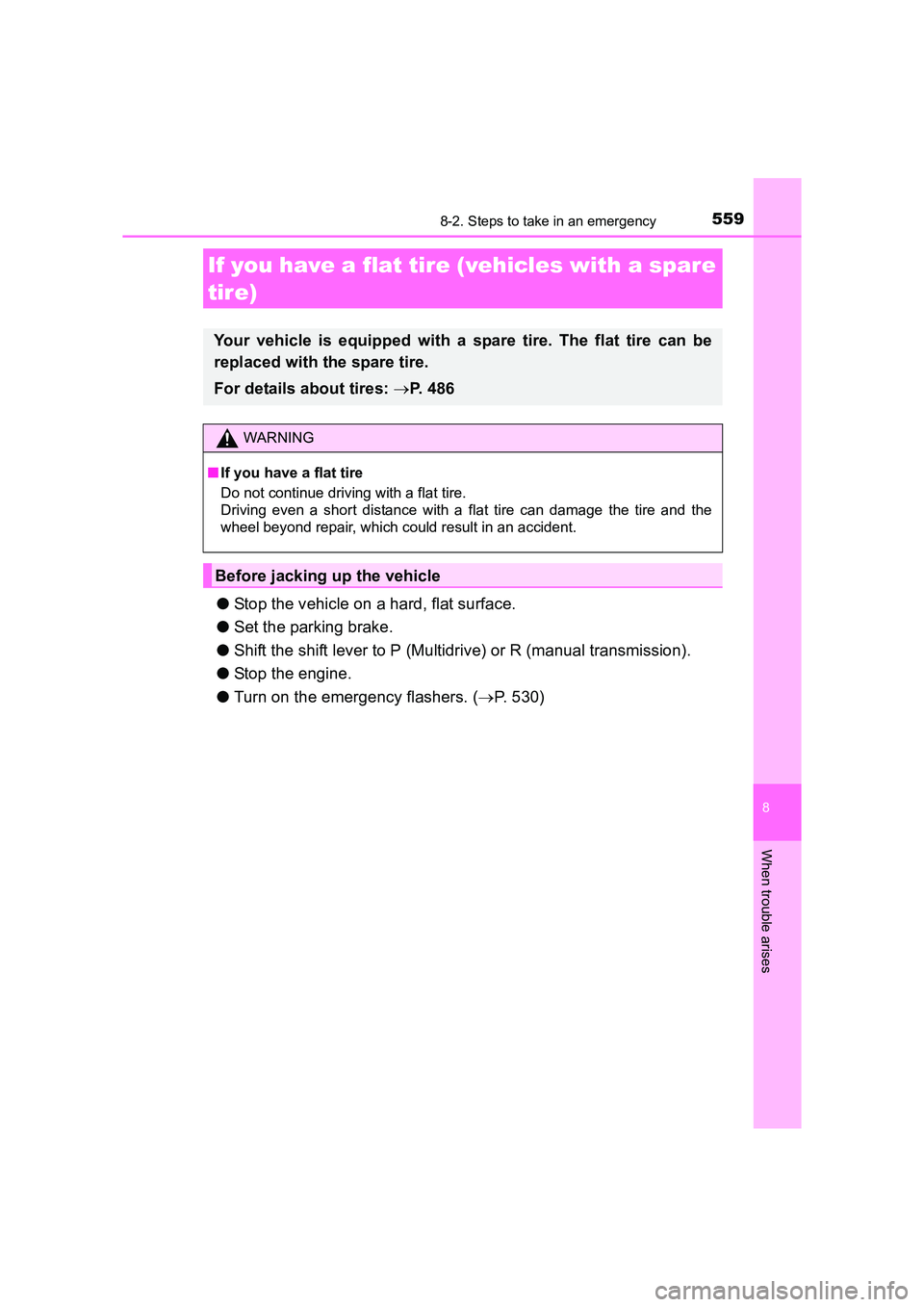
5598-2. Steps to take in an emergency
AURIS Touring Sports_EE (12K53E)
8
When trouble arises
‚óŹStop the vehicle on a hard, flat surface.
‚óŹ Set the parking brake.
‚óŹ Shift the shift lever to P (Multidrive) or R (manual transmission).
‚óŹ Stop the engine.
‚óŹ Turn on the emergency flashers. ( ‚ÜíP. 530)
If you have a flat tire (vehicles with a spare
tire)
Your vehicle is equipped with a spare tire. The flat tire can be
replaced with the spare tire.
For details about tires: ‚ÜíP. 4 8 6
WARNING
‚Ė† If you have a flat tire
Do not continue driving with a flat tire.
Driving even a short distance with a flat tire can damage the tire and the
wheel beyond repair, which could result in an accident.
Before jacking up the vehicle